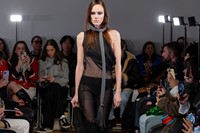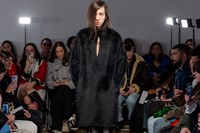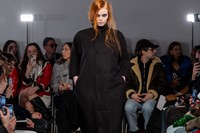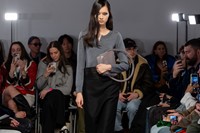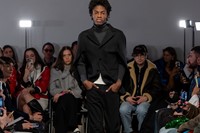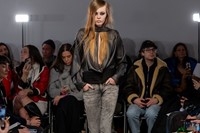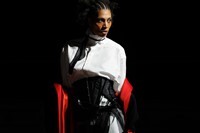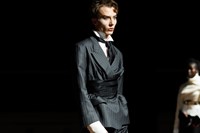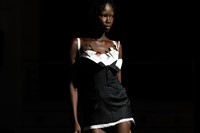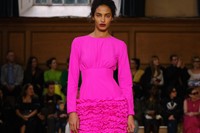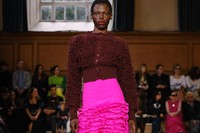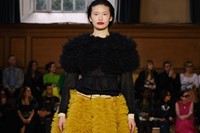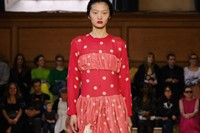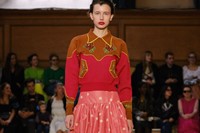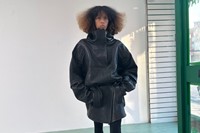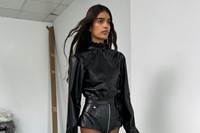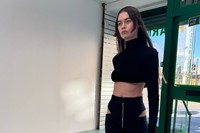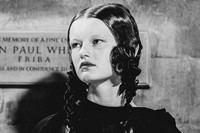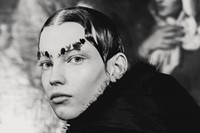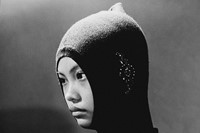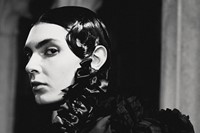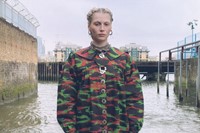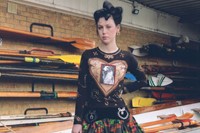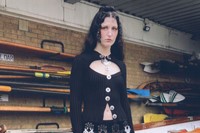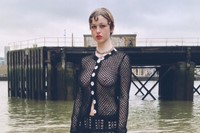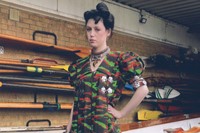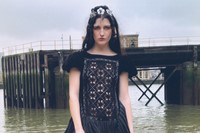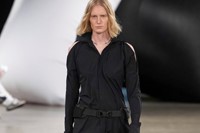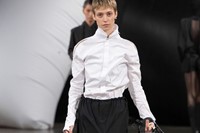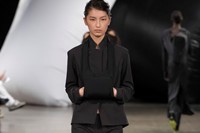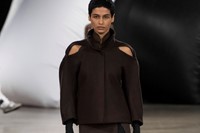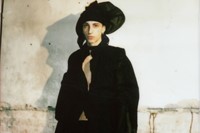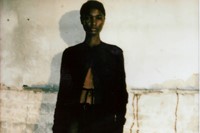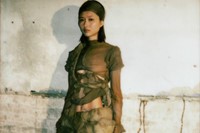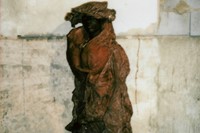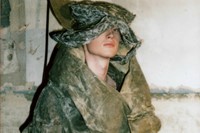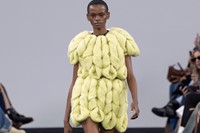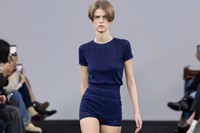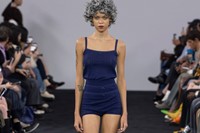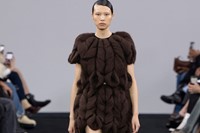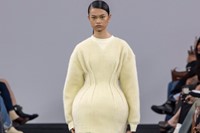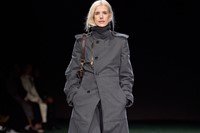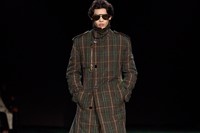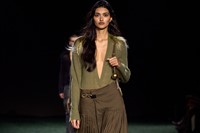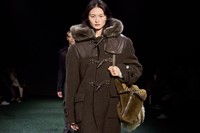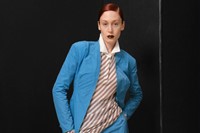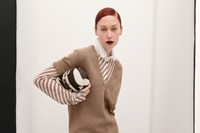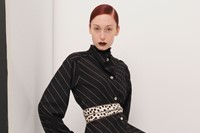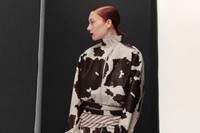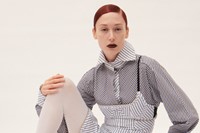From Simone Rocha’s mournful Queen Victoria-inspired collection to Aaron Esh’s nonchalantly chic show at the Sarabande, here are the best shows from London Fashion Week Autumn/Winter 2024
Aaron Esh
Aaron Esh has had a great start in fashion, and it’s no mere miracle. His debut collection last season was shown in the Tate Modern’s sixth floor, and reflected the city in which he lives. This season he showed in east London’s Sarabande Foundation, where in autumn the designer moved his studio, thanks to their scholarship – it’s a building he already calls “home”. His new collection was a refinement of the groundwork he’d laid previously, reflecting the nonchalant chic of “throwing things on” after the afters, redolent of fags and booze. Cocooning jackets had couture shapes, jeans were skinny, and hands were shoved in pockets as if reaching for that last Marlboro Gold. It’s part and parcel with the world Esh is building – it’s not just about the clothes. “Definitely, I’m a perfectionist,” he told AnOther last season, “but for a world that’s not aiming to be perfect.”
Dilara Findikoglu
Dilara Findikoglu cited a lack of funds as the reason she was unable to show last season, which is sadly the reality for even the buzziest of designers – but now she’s back with a bang, and her latest show was a refusal to do anything by halves. On Sunday night in an east London church, with a seating plan akin to a gladiator’s pit, Findikoglu’s Femme Vortex was an extravagant affair replete with her signature occultic take on sexuality. Donning BDSM latex, deconstructed tailoring and corseted all-leather looks, models were taught a formidable, empowered stride by movement director Pat Boguslawski (à la the revolutionary recent Maison Margiela couture show). The press notes called the show a “mass ritual”, manifesting a femme world without patriarchy, and Findikoglu’s growing cult might just overturn fashion as we know it.
Molly Goddard
Under a vast mural by English painter Ivon Hitchens in Cecil Sharp House, a light-filled arts centre next to Regent’s Park, Molly Goddard sent her models out in a cacophony of colourful dresses inspired by 1960s Cristóbal Balenciaga and Christian Dior gowns. The silhouettes this season were looser and rounder than usual – or, as the designer herself described them, “blobs on blobs, two become one” – with iridescent smocked tops worn over billowing, poofy skirts in neon fuschia, hot pink and midnight purple. Western-inspired cowboy boots, shirts, and jeans, embroidered with a red rose motif, were inspired by kid’s cowgirl dresses the designer keeps saved on her eBay watchlist – an ever-evolving source of inspiration.
Supriya Lele
Instead of putting on a show, this season Supriya Lele invited press to Qrystal Partners, an art gallery she opened with curator Donald Ryan last year in a disused pharmacy in Southwark (the green exterior of the shopfront is unchanged since the shop’s former days as a real pharmacy, and people passing by often mistake it for one). Shot against the backdrop of the gallery’s sparse white walls and green-marbled linoleum floor – Lele’s studio is located above the gallery in an old office block, hence the symbiotic relationship between art and the brand – the sensual collection was shot through with blue, the designer’s favourite colour, inspired by William Gass’s 1976 philosophical treatise, On Blue. Sexiness and wearability were the main things here, with transparent vinyl sheath dresses, sheer black blouses (ideally worn with no bra), zips in suggestive places (on leather pants, and on a dress that zips all the way off via the sleeves), and a slouchy pullover ski jacket in leather inspired by the one Lele found herself wearing all winter.
Simone Rocha
Only one month on from showing her coquettish guest couture collection for Jean Paul Gaultier in Paris, Simone Rocha presented The Wake, the third and final part of a triptych of shows revolving around the collaboration, which began with S/S24’s The Dress Rehearsal. Queen Victoria’s all-black mourning dresses provided the inspiration for the show, which was held in a similarly mournful, sombre venue: London’s oldest parish church, St Bartholomew the Great. With flashes of faux fur (on shoulders, hips, pockets, hands, and the hems of skirts), delicate boning, bedazzled Crocs, cascading ribbon earrings, and furry animal clutches across both her womenswear and menswear, this was a collection inspired by mortality, the preserved garments found in Gaultier’s archive, and how one can breathe new life into old clothes.
See Paul Phung’s photos from the show here.
Chopova Lowena
Like other business-savvy young London brands hoping to keep their finances in check, Chopova Lowena made the decision to stage only one runway show per year, instead of the standard two. Fresh from their riotous show at a west London skatepark last September, this season Emma Chopova and Laura Lowena-Irons released a romantic lookbook shot at the Deptford Sailing Club (a stone’s throw from their new south London studio), with a collection which merged the unlikely themes of sailing and wartime weddings. “I love the sea. Everything about it makes me feel good and relaxed,” said the pair in an exclusive preview. “I think there is something very romantic in sailing and I love the whole aesthetic of it – the boats, the sales, the outfits.”
Read AnOther’s feature on the collection here.
Fashion East
It’s rare that the designers showing under Lulu Kennedy’s infamous talent incubator, Fashion East, have much in common, but this season, Johanna Parv and Olly Shinder – the only two designers currently on their runway roster – share a heightened sense of tailoring, technicality and sensuality. Parv’s third and final collection for Fashion East was designed for women battling their way through the wintery morning commute on a bike or on foot, with slick and elegant wool blazers, mini-skorts, lycra dresses and functional bags executed in a darker colour palette of earthy browns, aqua green and tourmaline blue. Casting was king at Shinder’s second collection under Fashion East, with a host of models drawn from the designer’s creative community strutting down the runway to a soundtrack by Wolfgang Tillmans, in an erotic mashup of workwear and tailoring drawing on (and subverting) the aesthetics of the scientist’s laboratory.
Paolo Carzana
When Cathy Horyn praised Carzana for designing one of the four leading collections last London Fashion Week in an article for The Cut (alongside some immense players like Burberry and JW Anderson), we knew it wouldn’t be long before his ‘emerging’ descriptor was dropped. Presented at Regent Street’s Newgen space, the Welsh designer’s 16-piece A/W23 collection, titled Melanchronic Mountain, symbolised an arduous ascent into greener pastures. Carzana’s play with textile feels like big-time fashion – not in a slick Tom Ford-ish razzle-dazzle way, but with a feeling of something emotional, intuitive and, crucially, new. He’s hand-dying clothes from plants and vegetables, whipping them onto the body, revealing their frays, tatty but robust. If the collection was a meditation on better days, London’s fashion scene has, in part, Carzana to thank.
JW Anderson
Jonathan Anderson was focused this season. His previous themed shows at JW Anderson, like his squishy play-doh S/S24 show and his Michael Clarke-inspired collection for A/W23 were blown-out fantasy worlds amid impressive staging and glittering motifs – but here, the theme was more of a feeling. “Instead of nostalgia, colloquialism,” Anderson wrote in his press notes. “In lieu of the sensational, the non-apparent. Rather than notoriety, being secretive.” Shifting his focus to clothes, Anderson had free reign to play with his signature twists on proportion, with coats that hang from the body and jumpers that cinch at the waist before bulging at the hip, elevating basics to create something wholly different and new.
Burberry
Daniel Lee’s Burberry is iconically British by virtue of some pretty stellar British icons. The leaves are yet to return to the trees in east London’s Victoria Park, but in Burberry’s football pitch-sized tent, there was a warm, wintery feeling as models wrapped in earthy browns and rich greens roamed around its roomy interior. Not just any models: to a soundtrack of some Amy Winehouse’s greatest hits, Naomi Campbell, Lily Cole, Lily Donaldson, Agyness Deyn and Karen Elson all walked, while Maya Wigram, the daughter of Phoebe Philo (Lee’s former boss), closed. The motivation behind the clothing was warmth. Coats were ubiquitous, coming in shearling and heavy fringe, while collars came hoisted high against the neck, and scarves were wrapped around the head. Hailing from Bradford, West Yorkshire, Lee is attuned to our precarious weather and our quirky traditions. It’s a funny little nation we live in, and Burberry is unearthing the glamour in it.
Talia Byre
Talia Byre closed out London Fashion Week with a cosy evening of drinks and nibbles at her new studio space in Hackney Depot, an architectural wonder housed in a former bus garage. A sense of intimacy, and of friends and family coming together, has always been a key part of the designer’s world across her shows at restaurants, wine bars, and bookshops, and this season was no different. With a lookbook shot by Esther Theaker, the collection’s loud sense of pattern and colour – in stripes, houndstooth, and delightfully clashing combos of cow and zebra – was inspired by the ‘sweater girl’ archetype of 1940s and 50s Hollywood, Modigliani’s paintings of his partner, the writer Beatrice Hastings, and 60s girl groups like The Shangri-Las, whose song Hate to Say I Told You So provided the name of the collection.

